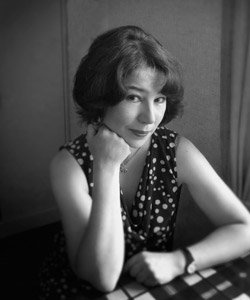25 October 2017 - Session 3
-

Alison Hilton
How to formulate the new art: national singularity and tentative modernism at international exhibitions
The experience of exhibiting at World’s Fairs, Salons, and the Secession exhibitions at the end of the 19th century offered Russian artists new standards for evaluating their own progress in an increasingly international art world. They were naturally attuned to the perceptions of their European peers and reviews in the press. For the most part, the comments in artists’ letters from Paris, Munich, and other cities focus on their personal observations of contemporary European art and artists, though they offer indirect information on the reception of Russian art abroad. They also give a sense of the difficulty Russian artists faced in coping with the conflicting demands of nationalism and new formulations of art.
The question of nationalism arose at the first major exhibition of Russian art abroad, at the London World’s Fair of 1862; some critics found the art derivative and lacking in any truly national character. Nearly fifty years later participants in the Russian section of the Munich Secession in1898 had the satisfaction of finding the international art scene stimulating rather than intimidating. But some doubts about identity could still be felt. Mikhail Nesterov, whose work expressed a spiritual inner vision rather than the spontaneity of optical impressions, was afraid that his religious images were too subjective to be understood by foreigners. Taking this lingering hesitation as a starting point this paper considers some consequences of Russian artists’ concerns about their reception abroad around the end of the 19th century. Sergei Diaghilev among others articulated both positive aspects of national character and limiting ethnographic crudeness, while Nesterov suggested that Russian subjectivity might enrich or even redefine a new international art. -

Rosalind P. Blakesley
The First Female Peredvizhnik: the Case of Emily Shanks in Russia and Britain
In 1894, the British artist Emily Shanks (1857-1936) became the first woman to be elected a member of the Peredvizhniki. Born and resident in Moscow, she and her family formed part of a close-knit circle of highly cultured Russophiles. Her older sister Louise married Aylmer Maude, and with him produced a series of acclaimed translations of the works of Tolstoy into English. Her younger sister Mary, another artist, befriended Tolstoy’s daughter Tatiana and produced illustrations for some of Tolstoy’s short stories. Emily and Mary were also friends with Elena Polenova and Vasily Polenov, with whom they often painted together. Drawing on the rich but largely unmined Shanks family archives, this paper will explore these various relationships, and position Emily as an important but overlooked conduit of Anglo-Russian artistic exchange.
Emily’s paintings – held in family as well as public collections such as the State Tretyakov Gallery, Polenovo Museum Estate and the Tyumen Regional Museum of Fine Arts – focused on portraits and genre scenes of women and children. These were exhibited in most of the Peredvizhnik exhibitions from 1891 to 1915, as well as occasionally at the Royal Academy after the family moved back to London at the outbreak of World War I. The nature of their reception in the two different countries will be examined here, not least to identify those aspects of her work which persuaded the Peredvizhniki to admit Emily into their famously exclusive group. Yet many of Emily’s paintings query not only the supposedly entrenched Realism of the Peredvizhniki by the 1890s, but also the interface between Realism and Impressionism. Her work will therefore be used here as a case study to revisit these hard-cast categories, and suggest that late Realism was not always the moribund relation but often a vibrant and reflective interlocutor of modern Russian art.
-

Ekaterina Vyazova
M. Larionov and R. Fry: Toward the History of Sergei Diaghilev's Ballets Russes in Britain
The early twentieth century was characterized not only by the inclusion of Russian art in the European art world, but also by the creation of entire projects representing Russian culture to European audiences. In them we see a curious paradox: the more Europe- and Western-oriented such projects appeared relative to Russian culture, the more exotic they looked in Europe. Sergei Diagilev organized his Russian Seasons according to his westernizing program. At the same time, they defined the main vector in creating a mythologizing image of Russian culture as purely exotic. It is notable that Diagilev’s Russian project regularly included artists close to the World of Art—the leading Europeans in Russian culture of the turn of the century. In contrast, the most Russian exemplars of European modernism were viewed in Europe as part of the artistic mainstream. For example, Ivan Bilibin’s neo-Russian style became the most international phenomenon of the World of Art and was perceived as such in England in the 1910s. Similarly, the Russifying works of Maria Yakunchikova and Yelena Polenova received a similar response. It was not by chance that English magazines The Studio and Artist were interested in Polenova’s works. Such transformations of Russian artistic Westernizing into a kind of Slavophilism in Europe and vice-versa cannot be explained by Western demand for Russian exoticism. It was a matter of the specific features of Russian Westernization and Slavophilism.
Although the World of Art group knew European art well, their Westernizing was an ideal point of view, born out of the necessity to construct a position of the bearer of an outside gaze. Such Russian variations on the theme of Europeanization were read in Europe as purely national. At the same time, the European reception of Russian art as “one’s own but different” encouraged tendencies toward transformation that existed in Russian Westernizing (particularly in its World of Art iteration). In this case, imaginary Europe was easily interchanged by creating an integral project of a mythologized Russian culture. Thus the art of the World of Art presented by the Russian Seasons joined organically with the works of Natalia Goncharova and Mikhail Larionov, for example, with their programmatic anti-Western orientation. My presentation will address the reception of Diaghilev’s Russian Seasons in Europe, which has predetermined in many ways the logic and history of the metamorphoses of Russian artistic Westernization.
